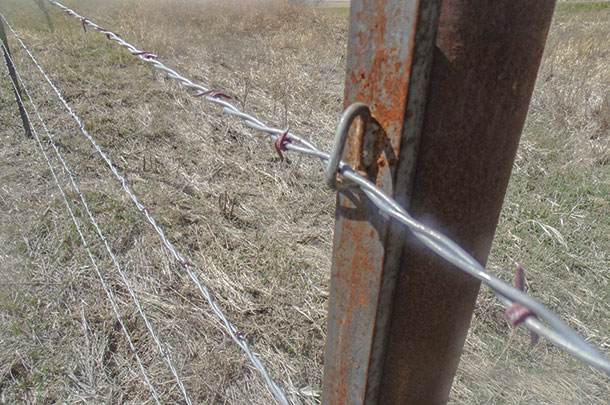People who build a lot of fences find innovative and effective ways to get the job done.
Wood posts or metal posts
Nick Thomas, who builds custom fences in Idaho, says one option in rocks is digging holes for brace posts with a backhoe. This makes a too- large hole, but it can be backfilled when setting the post.
In terrain too steep to get a backhoe or tractor to the fence for digging or pounding posts, he uses a roto-hammer electric drill that runs off a portable generator. “This works for drilling holes into solid rock to insert a steel post or a bigger hole for a brace post,” says Thomas. A rock drill is more portable than a jackhammer and has several bits, including 1.5-inch chisel bits for drilling into solid rock.
“This drill makes a hole exactly the right size for a metal T-post,” says Thomas. “In solid rock, you only need to drill down about a foot and drop the post into the hole, and it’s tight, because there’s no give in the surrounding rock. For a brace post, you can make a deeper hole using long bits that can go down about 30 inches.”
Another strategy for rocks or frozen ground when using a post pounder to set wood posts is a metal “post” to create a pilot hole. It will often go down through rocky ground if it’s not solid bedrock, pushing aside the rocks, or penetrate frozen ground, whereas a wood post would be forced out of line or shatter. It’s easy to make a 7-foot metal pilot post to create holes for wood posts.
“The one we use is about 3-inch diameter and creates a hole to start the wood post into,” explains Thomas. “The pointed bottom is solid steel, 3 feet long, and the rest is hollow, which makes it lighter to carry.
The top has a solid cap for the post pounder to hit. You drive the pilot post as far as you can, pull it out with the tractor or skid steer loader and insert your wood post into the hole and drive it in – forcing it into the slightly smaller hole – and it is very solid and secure.”
In terrain where it’s too rocky to set wood posts, if there are surface rocks, you can create an above-ground basket of rocks as a solid brace to anchor the fence. Gather or stack rocks and secure them with net wire or make a wire cage to put rocks into it.
“A rock-filled cage 3 to 4 feet in diameter makes an anchor to secure your wire and stretch it,” he says. If terrain is too rocky to set wood posts, you can usually put steel posts in the ground deep enough to hold, using rock baskets every so often for braces.
Other alternatives are above-ground fences such as jack fence (buck fence) or worm fence. A worm fence is created by stacking logs or large-diameter poles upon one another, interlocking in two directions. The finished fence is a continual series of corners/angles.
A pole jack fence works where ground is too rocky or swampy to set posts, but in windy country must be anchored so it won’t blow over. “To keep it from tipping over, you can hang a large rock under some of the jacks or make a rock basket with the jack secured to it,” Thomas says.
Pipe fence posts
Dick Iversen of Timber Creek Ranch in Culbertson, Montana, has had experience building fences and hiring fence builders. “We had a flood in 2011 and had to replace 7 miles of fence on our river bottom place. Then we had a fire last summer and are now replacing 6 miles of fence between us and a neighbor in rough terrain,” he says.

“For interior fences, we use electric fence because it’s easier to build. In winter, I put in step-in portable posts, using a cordless drill to make a pilot hole in frozen ground,” he says. But for permanent fences, he likes posts made from oil field drill-steel pipe.
“When we had the fire last July, the pipe posts did not burn. Oil field pipe is surplus and can be purchased reasonably. It comes in 30- to 33-foot lengths but is easy to cut into post lengths with an electric hand-held band saw. If I’m cutting pipe in a place where there’s no electricity, I use a little portable Honda generator,” says Iversen.
“Once a pipe post is set, the ground tends to rust it to the soil around it, and it’s very solid – and difficult to pull back out. These posts work really well for corrals. An 8- to 9-foot pipe post is about all one person can lift and so sturdy that nothing is ever going to bend or break it.
The new fracking wells in the oil fields [pumping water into the well and back out] use clean salt water, so the pipe isn’t rusty like some of the older oil field pipe,” he explains.
“H2S gas [hydrogen sulfide] is the stinky gas [smelling like rotten eggs] that comes from some of the older wells, and if you get that kind of pipe, it will rust out fairly soon, but pipe from the newer wells will never rust,” he says.
Todd Hermanson of Hermanson Fencing Company Inc. is building Iversen’s new fences. Hermanson has been building custom fences for 35 years in three states. He used to do traditional fences with wood and steel posts, but now uses discarded drill-steel pipe. With a jackhammer-type hydraulic post pounder he invented, he can pound pipe posts into any kind of terrain – solid rock, frozen ground or bogs.
“This kind of fencing started with us. We modified Bobcat hydraulic cement breakers for pounding posts. It was trial and error, but I have a guy in my shop who is pretty good at making things. We came up with a whole system to do this kind of fencing – and it has caught on like crazy in our country,” he says.
“We’ve had many fires in this region that burned up all the wood fences. Our pipe fences are still standing; pipe posts will last more than 50 years.” A person might have to replace wire if a really hot fire makes it brittle, but pipe posts will still be there.
“The only thing that might shorten the life of these posts would be alkali ground that tends to eat up metal. It’s easier to put a pipe post back in, however, than a wood post. It takes two minutes to pound another pipe post. Even when repairing fence, if there’s a broken or rotted-off railroad tie, we don’t have to dig it out; we just pound a pipe down through the middle of it. This saves a lot of time,” says Hermanson.
“When we put fences across creeks or gullies, we have a way to deal with this, and it’s all pipe. It’s very cost-efficient and will be there a long time.” The pipe holds much better in places where it would be hard to brace with wood posts or traditional steel posts.
Some of the government-funded fencing projects have been slow to allow this kind of fence, however. Iversen worked with NRCS for years, and their fencing projects required a wooden double-H brace.
“It’s only been in the last six years that they’ve allowed pipe posts for braces. Todd Hermanson and I worked with our state office to get them to approve that type of bracing. Now several states approve it, because it’s stronger, holds better and lasts longer than wood braces and take less time to install,” Iversen says. ![]()
PHOTO 1: This photo shows jack fence across boggy areas where it would be difficult to set wood posts that will hold.
PHOTO 2: A tiedown is attached to pipe post. Photos provided by Heather Thomas.
Heather Thomas is a freelance writer based in Idaho.









